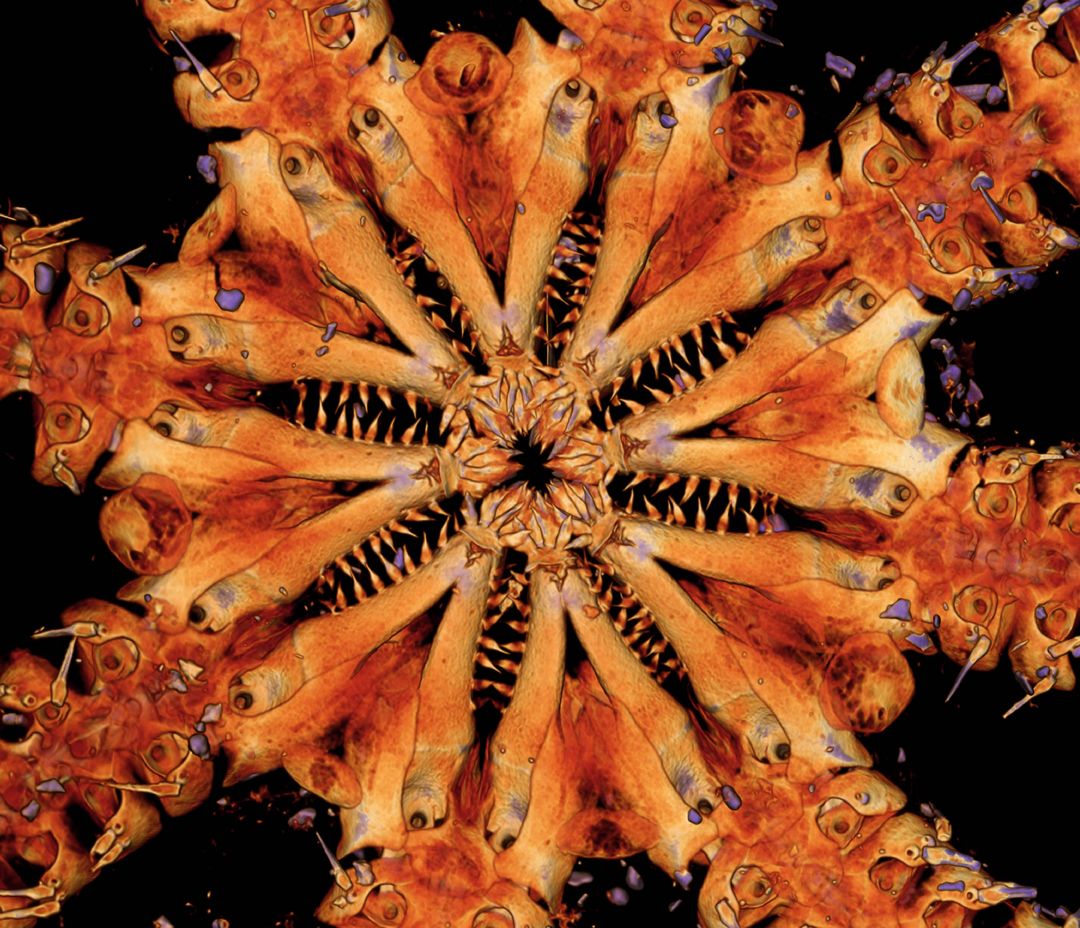Sea snot, stars and sleeping elephants — June’s best science images
The month’s sharpest science shots, selected by Nature’s photo team.

Deep-sea star. This brittle star, called Ophiojura exbodi, belongs to a newly described species, genus and family, and was found on the sea floor at a depth of more than 360 metres, at a site near New Caledonia in the Pacific Ocean. Brittle stars are echinoderms — the animal group that also includes starfish, sea urchins and sea cucumbers. Like starfish, they use their flexible arms to crawl along the sea floor. Most have five arms, but this unusual specimen has eight, along with eight sets of teeth surrounding the circular mouth in the centre of its body. Researchers say it belongs to a lineage that split from other brittle star families around 180 million years ago, in the late Triassic or Jurassic period.

Weary wanderers. Part of a herd of wild Asian elephants (Elephas maximus) was photographed napping near a village in Xiyang township, China, in early June. The 15-strong group had spent months travelling more than 500 kilometres across the country from their home on a nature reserve, for reasons unknown. The elephants have become beloved social-media stars. The authorities are carefully monitoring and protecting them, even though they have eaten millions of dollars’ worth of crops, damaged buildings and startled people in their homes.

Moon shot. NASA’s Juno spacecraft captured the first close-up images of Jupiter’s moon Ganymede in more than 20 years during a fly-by on 7 June, when it passed within 1,040 kilometres of the icy world. This preliminary image shows the many craters on the Jovian moon’s surface. It was captured using the JunoCam camera’s green filter — images from the instrument’s blue and red filters are on their way and will allow scientists to piece together a colour version.
Credit: DR Berger, A Shapson-Coe, JW Lichtman
Mind map. This exquisitely detailed image charts the connections between thousands of cells in a tiny sliver of human brain. The sample was taken from the cortex — the part of the brain responsible for complex thought — and cut into thin slices that were imaged using electron microscopes. Scientists then stitched the images back together digitally and analysed them with the help of artificial intelligence programs. These can, for example, map the positions of synapses — junctions where electrical signals pass between nerve cells. Different types of neuron have been artificially colour-coded.

Sea snot. Rowers near the Caddebostan shore of Turkey’s Marmara Sea cut through a layer of marine mucilage, a green-grey sludge that develops on the surface of the water owing to the proliferation of microorganisms. The substance, informally dubbed sea snot, was first documented in Turkish waters in 2007. Researchers warn that the mucilage is harmful to other sea life and is likely to occur more often in future because of climate change.

Credit: Steve Richardson
Credit: Steve Richardson
Chocolate frog. Meet Litoria mira, a new species of frog discovered in a swamp in New Guinea. Researchers found the cocoa-coloured amphibian while studying the evolution of one of its closest living relatives, the green tree frog (Litoria caerulea), which is found in Australia and New Guinea. Until about 10,000 years ago, these places were connected by a land bridge, and scientists have catalogued several other relatives of the green tree frog in New Guinea. Litoria mira — nicknamed ‘chocolate frog’ by the scientists who found it — is smaller than the green tree frog, but has an identical mating call, described as a “deep, rasping bark”.

White stripe. North America’s largest artificial reservoir, Lake Meade on the border of Arizona and Nevada, has dropped to its lowest level since it was first filled in the 1930s after the construction of the Hoover Dam. The drop is due to prolonged drought coupled with an increased demand for water in the southwestern United States. The white ‘bathtub ring’ around the edge of the lake is caused by mineral deposits on the rocks, which reveal how far the water level has fallen.

Credit: Rochelle Lawrence
Credit: Rochelle Lawrence
Not-mini Cooper. Palaeontologists Scott Hocknull and Robyn Mackenzie pose with a leg bone belonging to Australotitan cooperensis (nicknamed ‘Cooper’) — a newly identified dinosaur species that is the largest ever found in Australia. Cooper lived in the Cretaceous period between 92 million and 96 million years ago, and was probably 25–30 metres long, with a height of 5–6.5 metres at the hip. The giant sauropod was finally confirmed to be a new species after digital scans were used to compare its remains with other specimens. Here, Hocknull and Mackenzie are holding a 3D-printed replica of the humerus — the real fossil sits in front.